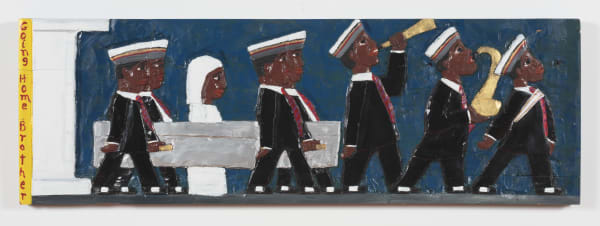Herbert Singleton American, 1945-2007
Herbert Singleton, factory worker and street hustler, chiseled and carved wooden weapons before turning to visceral carved and painted street narratives on found objects that today grace collections around the world.
Singleton was arrested as a young adult for various narcotics crimes and spent thirteen years in the Louisiana State Penitentiary in Angola between 1967 and 1986. After his release, he began making clay snake sculptures. Distraught by the fragility of unfired clay, Singleton switched to wood and began carving long ax handles into walking sticks. His customers were pimps, drug dealers, and horse-and-carriage drivers in the French Quarter. In fact, one carriage driver notoriously killed a robber during a mugging with one of Singleton's sticks, and thus they became known as "Killer Sticks."
By the 1980s, Singleton’s carvings caught the attention of local art collectors as his work became more complicated and political. He transformed discarded planks, chifforobe panels, and doors into symbolic friezes, depicting biblical scenes, Voodoo icons, and second-line parades. He also frequently depicted the poverty, drug abuse, and violence that plagued his Algiers neighborhood. He painted his carvings in bright colors with ordinary household enamel and inscribed them with cautionary phrases such as "Who do we trust?"
"He was a major force in the world of self-taught art," said William Fagaly, curator of African art at the New Orleans Museum of Art. "He wasn't imitating anyone else. He had his own voice. . . He addressed African American issues, race issues, inequality, and New Orleans traditions like jazz funerals, which are unique to this city. His pieces are not just powerful but beautiful."

